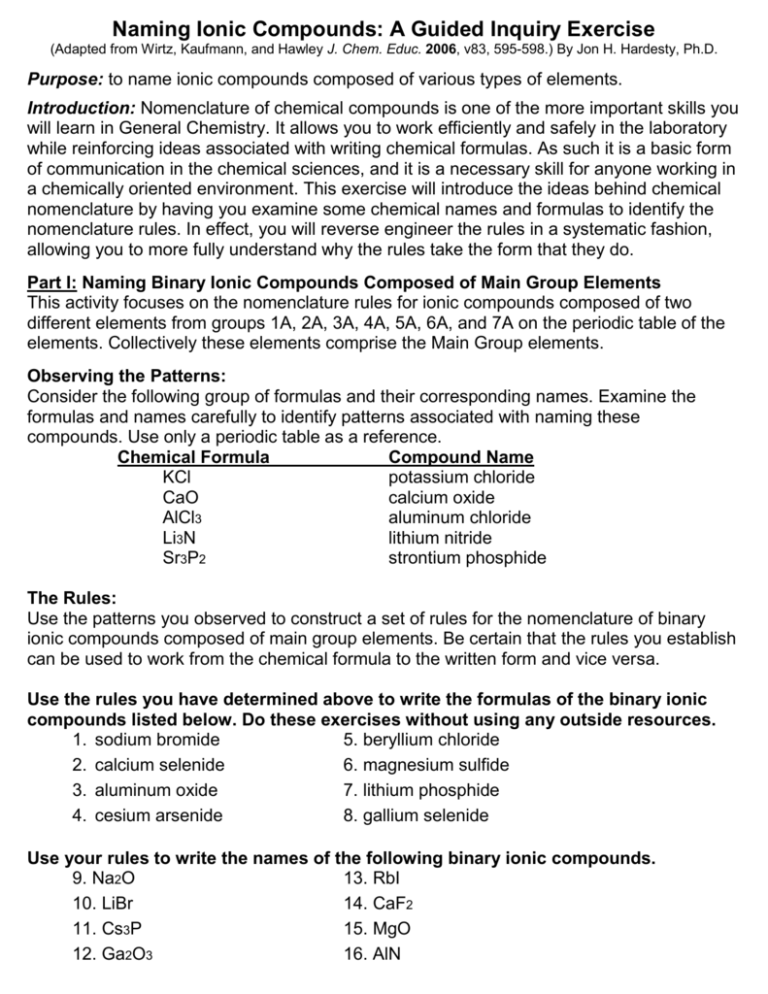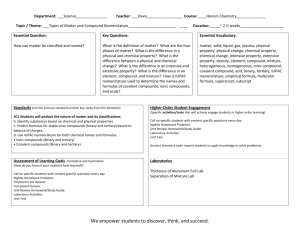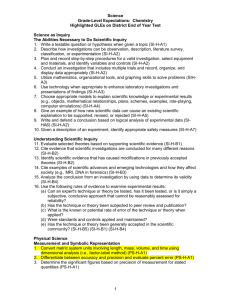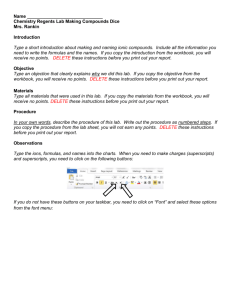Naming Ionic Compounds: A Guided Inquiry Exercise
advertisement

Naming Ionic Compounds: A Guided Inquiry Exercise (Adapted from Wirtz, Kaufmann, and Hawley J. Chem. Educ. 2006, v83, 595-598.) By Jon H. Hardesty, Ph.D. Purpose: to name ionic compounds composed of various types of elements. Introduction: Nomenclature of chemical compounds is one of the more important skills you will learn in General Chemistry. It allows you to work efficiently and safely in the laboratory while reinforcing ideas associated with writing chemical formulas. As such it is a basic form of communication in the chemical sciences, and it is a necessary skill for anyone working in a chemically oriented environment. This exercise will introduce the ideas behind chemical nomenclature by having you examine some chemical names and formulas to identify the nomenclature rules. In effect, you will reverse engineer the rules in a systematic fashion, allowing you to more fully understand why the rules take the form that they do. Part I: Naming Binary Ionic Compounds Composed of Main Group Elements This activity focuses on the nomenclature rules for ionic compounds composed of two different elements from groups 1A, 2A, 3A, 4A, 5A, 6A, and 7A on the periodic table of the elements. Collectively these elements comprise the Main Group elements. Observing the Patterns: Consider the following group of formulas and their corresponding names. Examine the formulas and names carefully to identify patterns associated with naming these compounds. Use only a periodic table as a reference. Chemical Formula Compound Name KCl potassium chloride CaO calcium oxide AlCl3 aluminum chloride Li3N lithium nitride Sr3P2 strontium phosphide The Rules: Use the patterns you observed to construct a set of rules for the nomenclature of binary ionic compounds composed of main group elements. Be certain that the rules you establish can be used to work from the chemical formula to the written form and vice versa. Use the rules you have determined above to write the formulas of the binary ionic compounds listed below. Do these exercises without using any outside resources. 1. sodium bromide 5. beryllium chloride 2. calcium selenide 6. magnesium sulfide 3. aluminum oxide 7. lithium phosphide 4. cesium arsenide 8. gallium selenide Use your rules to write the names of the following binary ionic compounds. 9. Na2O 13. RbI 10. LiBr 14. CaF2 11. Cs3P 15. MgO 12. Ga2O3 16. AlN Part II: Binary Ionic Compounds Containing Variably-Charged Ions The portion of the nomenclature system introduced in Part I is used to name binary ionic compounds composed of main group elements. However, there are numerous binary ionic compounds that contain transition metals or metals from the lower portion of groups IIIV of the periodic table. These elements are capable of bearing a variety of different cationic charge states. This activity builds upon the previous experiences of converting observed patterns in both chemical formulas and names into a set of rules that can be used to name all types of binary ionic compounds. Observing the Patterns Consider the following group of formulas and their corresponding names. Examine the formulas and names carefully to identify patterns associated with naming compounds. Use only a periodic table as a reference. Do not use any other outside sources. Chemical Formula Fe2O3 FeCl2 PbO2 CuSe KCl SnF4 NbCl5 Compound Name iron(III) oxide iron(II) chloride lead(IV) oxide copper(II) selenide potassium chloride tin(IV) fluoride niobium(V) chloride The Rules: Use the patterns you observed to construct a set of rules for the nomenclature of all binary ionic compounds. Be certain that rules you establish can be used to work from the chemical formula to the written form and vice versa. Use the rules you have determined above to write the formulas of the binary ionic compounds listed below. Do these exercises without using any outside resources. 1. cobalt(III) chloride 5. lithium arsenide 2. platinum(IV) fluoride 6. nickel(II) sulfide 3. chromium(III) oxide 7. beryllium nitride 4. titanium(II) chloride 8. iron(III) iodide Use the rules you have determined to write the names of the following binary ionic 9. MnF2 13. Ni3P2 10. PbS2 14. Cs2S 11. ScCl3 15. MgI2 12. PbS 16. CuSe Part III- Ionic Compounds Containing Polyatomic Ions The chemical nomenclature system was introduced in Part I and further developed in Part II. Both of these activities limited themselves to ionic compounds composed only of two elements, or binary ionic compounds. Part III introduces polyatomic ions, or ions containing two or more atoms covalently bonded and bearing a charge. This activity builds upon the previous experiences of converting observed patterns in chemical formulas and names into a set of rules that can be used to name all types of ionic compounds. Here is a list of some common polyatomic ions: Observing the Patterns: Consider the following group of formulas and their corresponding names. Examine the formulas and names carefully to identify patterns associated with naming compounds. Chemical Formula Compound Name (NH4)2S ammonium sulfide CoSO4 cobalt(II) sulfate Fe(OH)3 iron(III) hydroxide Ca3(PO4)2 calcium phosphate NH4NO3 ammonium nitrate The Rules Use the patterns you observed in parts I, II, and III to construct a set of rules for the nomenclature of all ionic compounds. Be certain that the rules you establish can be used to work from the chemical formula to the written form and vice versa. Use your rules to write the formulas of the following binary ionic compounds. 1. iron(III) acetate 5. aluminum hydroxide 2. strontium sulfate 6. lead(II) sulfate 3. copper(I) sulfide 7. ammonium nitride 4. potassium cyanide 8. magnesium carbonate Use your rules to write the names of the following binary ionic compounds. 9. Cu(OH)2 13. Sn(C2H3O2)2 10. Zn3(PO4)2 14. Pb(NO3)2 11. NaHCO3 15. FeCO3 12. NH4F 16. MgSO4 Analysis: Answer in Complete Sentences! 1. Compare the rules you developed with the real rules. What were the differences? Did you include all rules? Did you omit any rules or details? Answer all of these questions for each of the 3 types of ionic compounds. a. Binary Main Group Elements b. Binary Variably Charged Ions c. Polyatomic Ions 2. Review the real rules; go back and check if your names and formulas are correct. Circle 4 names and 4 formulas that you are confident are correct from EACH part. Naming Covalent Compounds: A Guided Inquiry Exercise Part IV: Binary Compounds of the Nonmetals The previous activities have introduced the nomenclature system and its use in naming ionic compounds. The rules for naming binary compounds composed of nonmetals are explored in this activity, building upon the previous experiences of converting observed patterns in chemical formulas and written forms into a set of rules that can be used to name binary compounds of the nonmetals. Observing the Patterns: Consider the following group of formulas and their corresponding names. Examine the formulas and names carefully to identify patterns associated with naming molecules. Use only a periodic table as a reference. Do not use any other outside sources. Chemical Formula NF3 NO NO2 N2O N2O4 Compound Name nitrogen trifluoride nitrogen monoxide nitrogen dioxide dinitrogen monoxide dinitrogen tetroxide Write down the patterns you observe in the both the chemical formula and written form for the compounds above. These patterns will later be used to establish the rules by which these compounds were named. The Rules Use the patterns you observed to construct a set of rules for the nomenclature of all binary covalent compounds. Be certain that the rules you establish can be used to work from the chemical formula to the written form and vice versa. Write these rules below. Use the rules you have determined above to write the formulas of the molecules listed on page 9. Use the rules you have determined to write the names of the molecules listed on page 10. Use the rules you have determined above to write the formulas of the following molecules. 1. carbon tetrachloride 5. dihydrogen monosulfide 2. phosphorus triiodide 6. sulfur dibromide 3. boron trifluoride 7. dioxygen difluoride 4. tetraphosphorus decaoxide 8. sulfur hexafluoride Use the rules you have determined to write the names of the following molecules. 9. N2H4 13. OF2 10. SBr2 14. BCl3 11. XeF4 15. ClF3 12. P4O3 16. CS2 Part V- Checking the Veracity of Your Rules Compare the rules you developed with the real rules. 1. How well did you predict the correct rules? Describe how your rules were similar and different from the real ones. 2. If you missed any major rules, what did you miss in your observations of the names and/or formulas in this exercise? 3. Are you confident that you can name ionic and molecular compounds given the formula, or of predicting the formula of a compound if given the name? Why do you feel this way?






